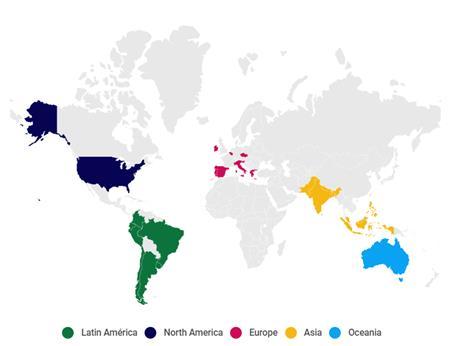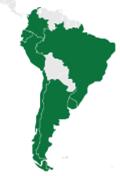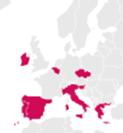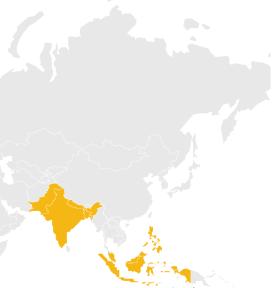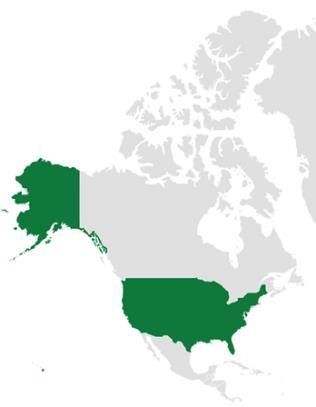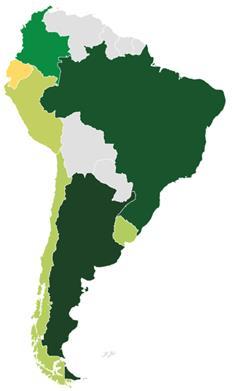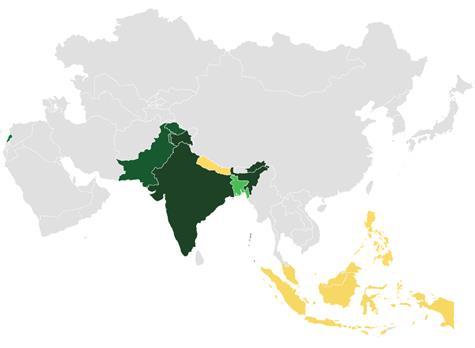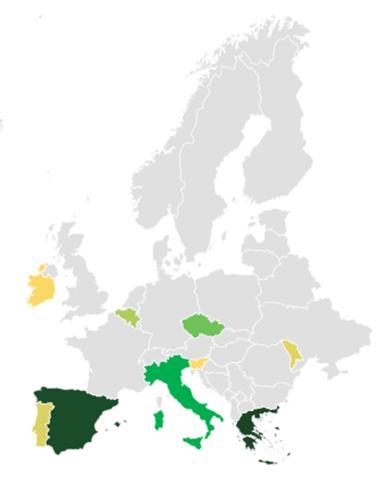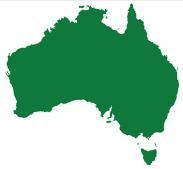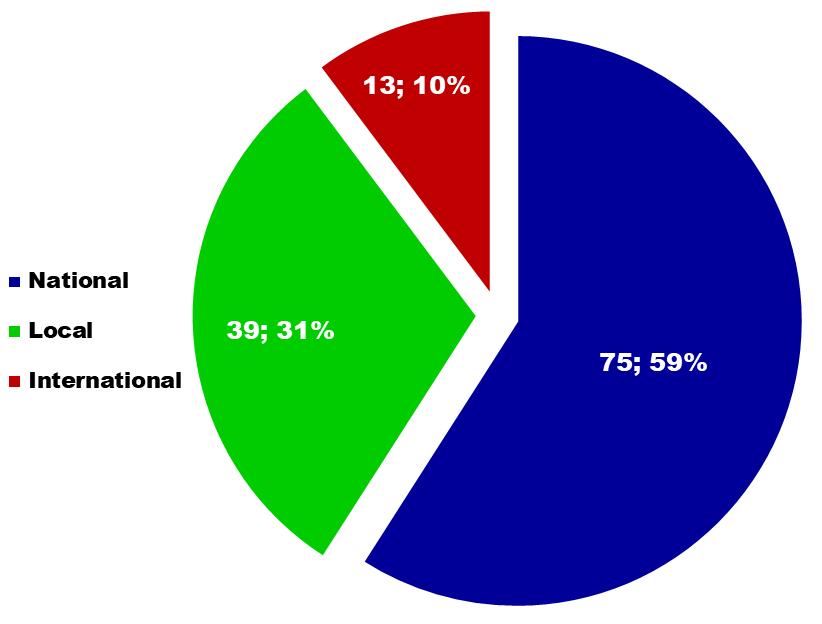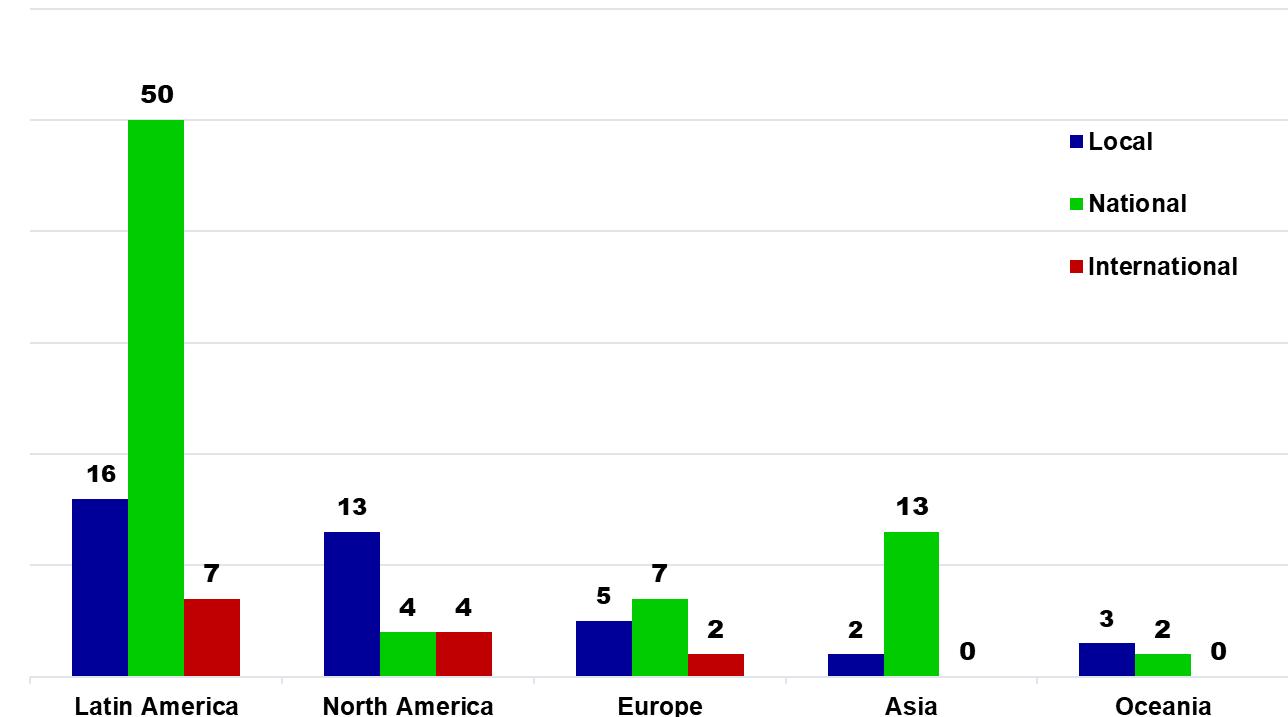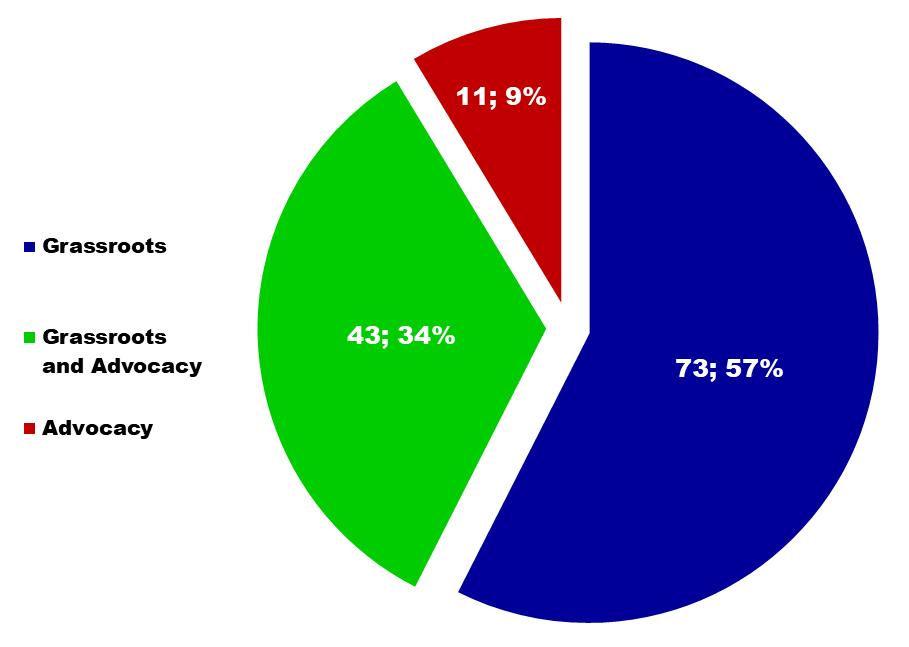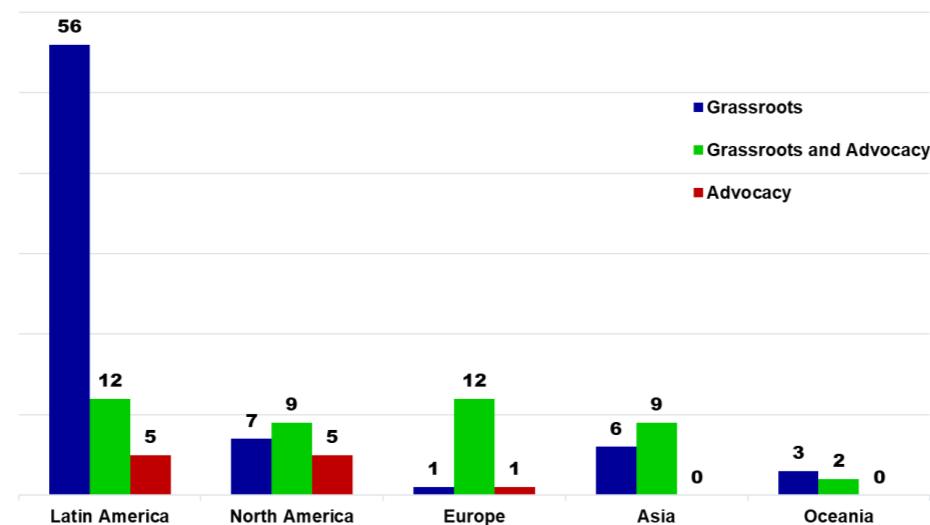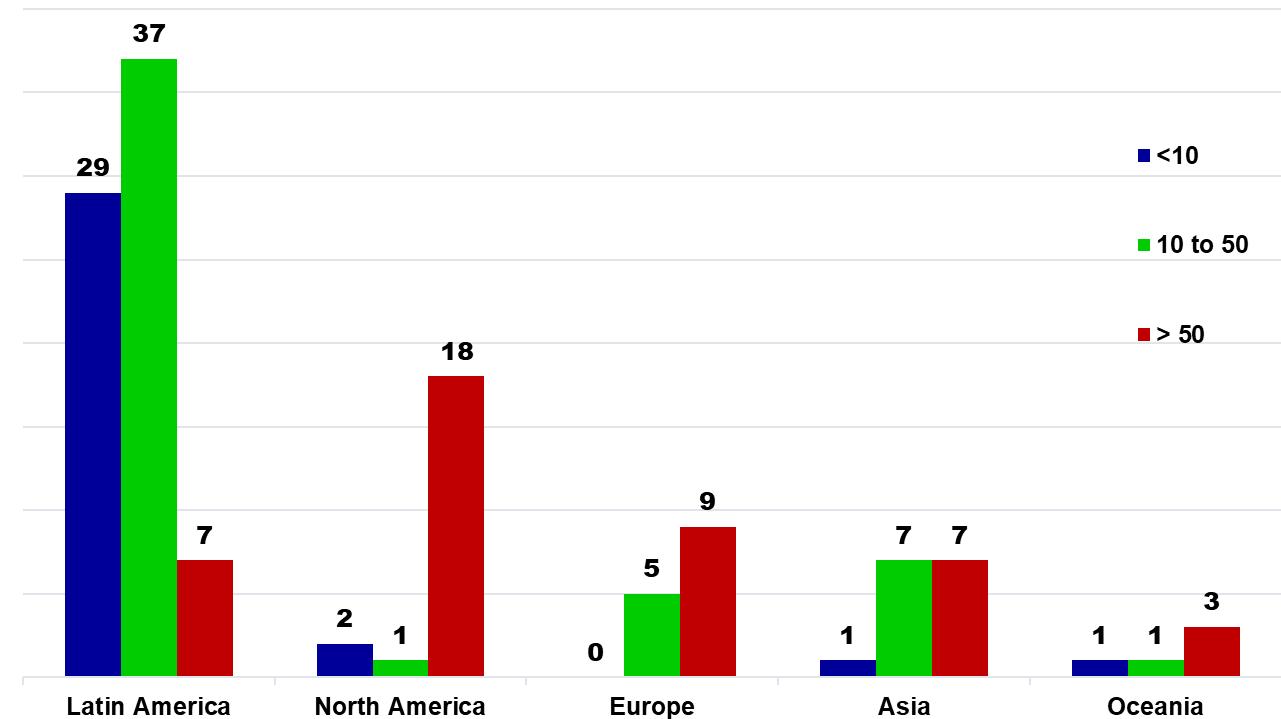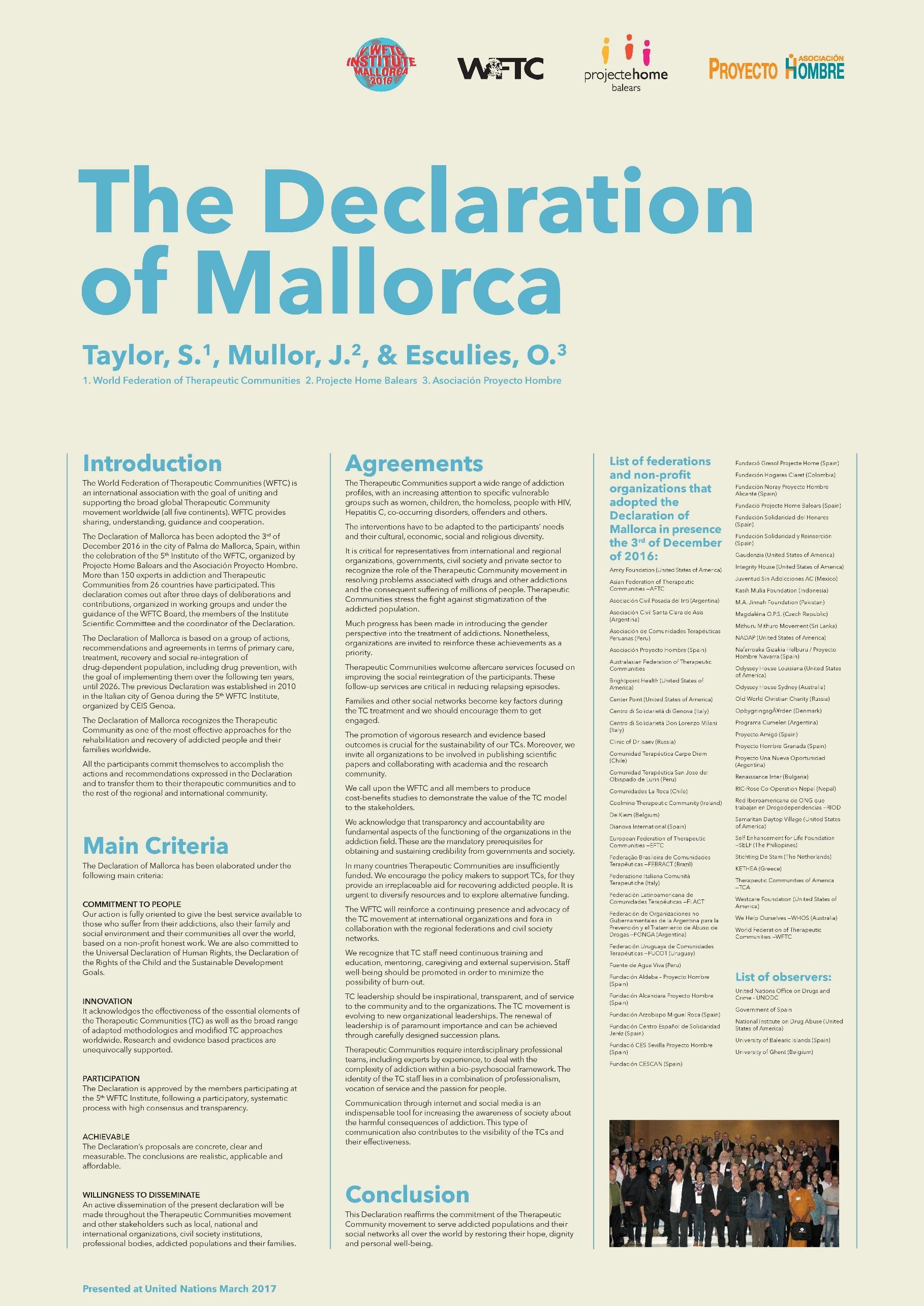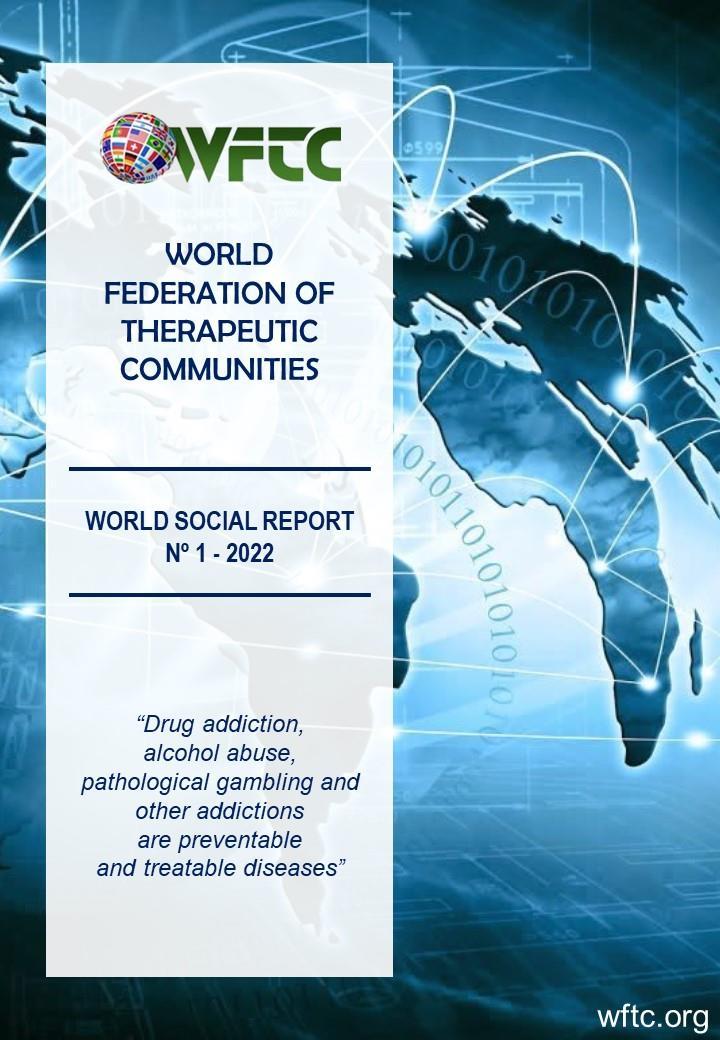




Table 1 - Total respondent organizations by Region 24
Table 2 - Total respondent organizations by country in Latin America 26
Table 3 - Total respondent organizations by country in North America 26
Table 4 - Total respondent organizations by country in Europe 27
Table 5 - Total respondent organizations by country in Asia 27
Table 6 - Total respondent organizations by country in Oceania 28
Table 7 - Total assisted and reached people of WFTC respondent organizations by Region 29
Table 8 - Total assisted and reached people in North America WFTC respondent organizations .........................................................................30
Table 9 - Total assisted and reached people in Latin America WFTC respondent organization 31

Table 10 - Total assisted and reached people in Asia WFTC respondent organization 31
Table 11 - Total assisted and reached people in Europe WFTC respondent organization 32
Table 12 - Total assisted and reached people in Oceania WFTC respondent organization 32
Table 13 - WFTC respondent organizations by Scope of work and Region 34

Table 14 - WFTC respondent organizations by Type of work and Region 36
Table 15 - WFTC respondent organizations by Number of employees and Region 38
Graph 1 - Respondent organizations country by Region 23
Graph 2 - Total respondent organizations by country 25
Graph 3 - Total assisted and reached people of WFTC respondent organizations by country 29
Graph 4 - Total WFTC respondent organizations by Scope of work 33
Graph 5 - WFTC respondent organizations by Scope of work and Region 34
Graph 6 - WFTC respondent organizations by Type of work 35
Graph 7 - WFTC respondent organizations by Type of work and Region 36
Graph 8 - WFTC respondent organizations by Number of Employees ............37
Graph 9 - WFTC respondent organizations by Number of employees and Region ........................................................................................................38 ___________________________________

Figure 1 - Total respondent organizations worldwide..........................................22

Figure 2 - People assisted and reached worldwide by WFTC respondent organizations 28
Figure 3 – Analysed characteristics of WFTC respondent organizations 33
Coordination of the Report
Coordinator - Sergio di Paolo (Italy)
Assistant Coordinator – Pablo Kurlander (Brazil) International Committee of the Report
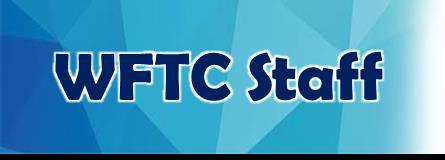

Ann Tucker (USA)
Boch Pavia (Philippines)
Edward Carlson (USA)
Enrico Costa (Italy)
Gerard Byrne (Australia)
Jorge Olivares (Chile)
Lucia Goberna (Spain)
Martin Infante (Philippines)
Miguel Garibay (USA)
Oriol Esculies (Spain)
Pablo Kurlander (Brazil)
Phaedon Kaloterakis (Greece)
Robert Budsock (USA)
Wouter Vanderplasschen (Belgium)
With the collaboration of CEIS Genoa - Italy
The “WFTC Social Report” indicates who we are, what our objectives are, how we function, who the recipients of our activities are and what results we have achieved.
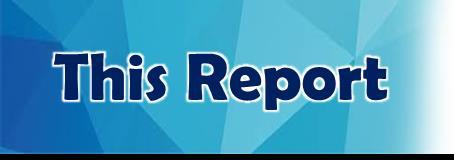

Through the “Social Report” the World Federation of Therapeutic Communities communicates:
• its universality, role and presence on the entire planet;
• its multiculturality, identity and consistency with its ethical principles;
• its professional reliability, its objectives and projects;
This is a “first” that we trust will improve year after year by deepening with more data the Federation'sgreat contribution and experiencein the fight against addictions.
Since 1975, the goal of the WFTC has been to cooperate in a worldwide association of understanding and cooperation within the global Therapeutic Community (TC) network. The WFTC calls for a holistic approach to healing, drawing upon all the disciplines, including medical, psychiatric, and social services, as well as TC trained professionals.



The present-day Therapeutic Community has roots in many different approaches and philosophies.Theseincludeearlypsychiatry, social psychology, the temperance movement and the charitable beliefs and service work of the Quakers.
The French physician Pinel referred to his methods as “treatment through the emotions”. This idea was later developed into “moral treatment”. The practice of moral treatment believed in the value of routine, engaging in a series of defined daily tasks, an established structure and a code of conduct, and the value of work within a family-like atmosphere.
Engagement in conventional activities which begin in the initial phases of psychoeducational treatment requires the development of a commitment to change, by developing the skills necessary to bring about change, with community integration to follow. Thus, long term success is dependent on the adoption, transference, and learning of coping and other skills.
The focus of WFTC's programs is the recoveryof the whole person. This includes the physical, emotional, mental, and spiritual domains. The goal of treatment is pro-social adaptation measured by abstinence from drug and alcohol use and criminal justice involvement; participation in recovery and other pro-social activities, employment and

The present-day Therapeutic Community has roots in many different approaches and philosophies.
productive, crime-free citizenship. WFTC promotes the values of self-help and selfreliance; the system of (community) rewards and feedback; the pride associated with achievement; the esteem derived from right living, and the progressive satisfaction achieved by doing good for others.

The major premise is that individuals' social needs are best expressed, explored, and satisfied in social interaction. This premise recognizes that the locus of psychological conflict is within the individual; that its source is in the network of social relationships in which the individual is embedded.
The major premise is that individuals' social needs are best expressed, explored, and satisfied in social interaction.
Using social contacts as a critical treatment instrument implies that adjustment is achieved first in societal and associational relations; then in family relations; and finally, intrapsychically. The direction of this change process has significant consequences on the conceptualization, organization, and implementation of services.

Therapeutic communities have worked to assist people with psychosocial problems for over 50 years. In that time much has changed:
• The number of organizations involved has increased substantially, as have the range of services and interventions offered.
• The legislative and regulatory framework has changed, thus providing new opportunities for services while also imposing new requirements, challenges, and opportunities.
• Wehavelearnedmuchabout thecomplexityofthe problems experiencedbythose who seek our help, and we have developed our capacity to respond.
• The multiple problems experienced by those who seek services require multimodality interventions in order to address these complex needs.
• The context in which we operate has also changed, with new patterns of dependence, a wider range of substances being used often in synergistic
combinations, as well as the normalization of substance use in some geographic regions.
• The accumulated weight of evidence gathered over the years has shown the effectiveness and the cost effectiveness of the therapeutic community at both the individual and community levels.
The changes which have occurred provide challenges which are being addressed by therapeutic communities worldwide. Amongst the manychallenges and opportunities, we recognize the following:
• We continue to strengthen our networking and have developed new ways of networking, formally and informally, to improve the quality and effectiveness of our service systems.

• We take pride that our programs provide the critical range of early intervention, treatment, education, training and support, while exchanging information about their best practices so that both professional competence and service delivery systems are continuously enhanced.
• We value the use of evidence-based interventions within the TC Methodological frameworktovalidatethatourinterventionscontinuetotargetthegoalofreducing individual and social harm while improving individual and social health in its broadest context.
In our work with people, therapeutic communities have proven themselves to be effective and to give added value by restoring families and protecting children, as well as a reduction in crime, improved health and restoration of individuals to social and personal responsibility.
We appreciate the recognition of the therapeutic communitymodel as an essential and effective component of a comprehensive prevention, treatment and social integration system.
We have developed the Social Report in order to provide a preliminary snapshot of the services being provided by some of our member organizations. We look forward to the development and distribution of future editions of our social report.
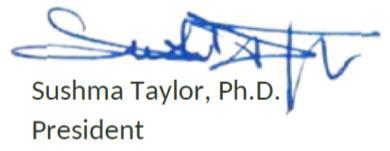

According to the latest United Nations World Drug Report, around 284 million people aged 15-64 used drugs worldwide in 2020, a 26% increase over the previous decade.
Of these, about 29.5 million (more than 10%) use drugs in a problematic way and have disorders related to drug use, including addiction, with an annual incidence of approximately 190,000 premature deaths due to drug use worldwide.
This same report points out that the social economic cost resulting from the use of illicit drugs is approximately 1.7% of the Gross World Product (GWP).

Young people are using more drugs, with levels today in many countries, higher than in the previous generations, and women are using drugs at the same rate as men, something new in the world scenario
At the same time, there is a growing need to face up to the social damage caused bydrugswithotheraddictions(especiallyalcohol)and theincreasingneedforprevention, especially for young people.

The World Federation of Therapeutic Communities (WFTC} is an international nongovernment association that engages in building collaborative coalitions and networks of social, education, and therapeutic systems that support the therapeutic community model of care.
WFTC is a broad global membership-based association which advocates for and promotes the understanding of the principles and methodologies that govern the therapeutic community methodology.
WFTC seeks to establish social learning initiatives, inter- country forums, crosscultural collaboration and regional networks. In addition, WFTC promotes the exchange of information, data, research, clinical trends, and emerging innovative strategies.

WFTC promotes standards of care for practice, quality of programs and practitioners, while interfacing with other professional disciplines and providing information about the therapeutic community model of treatment and recovery.

The World Federation of Therapeutic Communities is divided into 5 large geographical areas and operates through 4 operational Committees.

GEOGRAPHICAL AREAS

The following are the goals of the World Federation of Therapeutic Communities:
• Increase public knowledge of the therapeutic community philosophy, methodology, and effective programs.
• Articulate standards of ethical practice for the therapeutic community model of care from the program, the practitioner, and the specific cultural perspective.
• Provide education and information pertaining to research, methods, approaches, and programs across the globe that incorporate the principles of the therapeutic community model of treatment.
• Provide information to policy makers, governing bodies, and institutions on the importance of a comprehensive strategy to address substance use disorder issues and the role of the prevention and treatment within a comprehensive continuum of care approach.
• Interface with other disciplines such as medicine, psychology, sociology, public health, social services, criminal justice, and other related fields to foster collaboration and mutual understanding.
• Provide members with opportunities to network, exchange information, share knowledge and ideas, learn from one another and engage in reciprocal awareness of individual and collective efforts.
To learn more or join the WFTC please link wftc.org


WFTC is the major international member association practicing and promoting the Therapeutic Community methodology. This methodology promotes solution focused rather than problem focused approaches to treatment and rehabilitation. WFTC acknowledges that the programs and services provided by its member organizations deal with sensitive issues.
Accordingly, WFTC understands the importance of its stewardship role over the programs and interventions that affect personal, community, institutional and social values.
Inherent in the mission of WFTC is the commitment to promote the human, civil, and legal rights and moral freedoms of those individuals who participate in Therapeutic Community model of care/treatment programs.
General Principles
WFTC members agree to the guiding principles of the WFTC Code of Ethics as a requirement for WFTC membership. Members agree to conduct services with the highest quality, integrity, and ethical standards of excellence.

WFTC members strive to benefit those whom they serve to promote the WFTC code of ethics.
WFTC members safeguard the rights and welfare of the participants served.
WFTC members are aware of their professional responsibilities to the communities and organizations in which they operate. WFTC members uphold

professional standards of conduct, maintain professional roles and obligations, and seek to manage conflicts of interest that could result in harm.
A. Fidelity and Responsibility
1. WFTC members seek to promote honesty and accuracy in the training and practice of the Therapeutic Community methodology, and refrain from any misrepresentations of the methodology.
2. WFTC members affirm that participants (residents) in their programs are provided with fairness and equallity regarding the quality of the processes, procedures, and services they receive. WFTC members exercise reasonable judgment and take the necessaryprecautions to ensure that their actions do not result in unjust or unlawful practices.
B. Integrity
1. WFTC members respect the dignity, the rights to privacy and confidentiality, and the self-determination of participants in their programs. WFTC members are also aware that safeguards are necessary to protect the rights and welfare of individuals who participate in their programs.
2. WFTC members are aware of and respect cultural, individual, and social differences including but not limited to those based on age, gender, gender identity, sexual orientation, race, ethnicity, national origin, religion, social orientation, disability, language, and socioeconomic status.

C. No harm
1. WFTC members do not engage in behavior that can be viewed as sexual harassment or sexual exploitation by staff or participants in their programs. Sexual harassment is solicitation, exploitation, physical advances, verbal or non-verbal conduct that is offensive and sexual in nature.
2. WFTC members do not engage in behavior that is harassing or demeaning to those who they work with or participants in their programs.

3. WFTC members take the essential steps to avoid harming participants, students, research participants, and supervisees. WFTC members do not facilitate, condone, assist, or allow any physical and/or emotional harm or degrading behavior in any form. This is defined as any act by which pain and suffering, whether physical or psychological is intentionally inflicted on a person.
In addition,thereisnoexploitation,suchasfinancialincentives,barteringwith participants, sexual intimacies with current or former participants or intimacies with relatives of current participants. In addition, financial transactions with participants must onlybein accordance with published/agreed upon fees for services. As early as possible, fee practices must be disclosed and not misrepresented. Bartering (acceptance of goods, services, or nonmonetary remuneration) should only occur if it is not clinically contraindicated and not exploitative.
D. Conflicting Relationships
1. WFTC member staff refrain from entering into relationships that could impair theobjectivity, competence,oreffectiveness in performingduties orotherwise exploit or render harm to the person with whom the professional relationship exists. WFTC staff refrain from a professional role when personal, scientific, legal, financial, or other interest could impair objectivity, competence or effectiveness.
2. WFTC member staff must not exploit participants, students or supervisees, in their programs. If a potentiallyharmful relationship has arisen, staff must take the necessary steps to resolve the situation in consideration for the affected person’s best interest and compliance with the WFTC code of ethics.
E. Confidentiality and Consent
1. WFTC member programs operate within the highest standards of confidentiality and patient protection procedures.

2. WFTC member programs have a fundamental obligation to take reasonable steps to protect confidential information obtained or stored in any medium.
3. Disclosures of confidential information is only permitted with consent, or when legally authorized
6. THE PRIMACY OF THE COMMUNITY AND COMMITMENT TO TRAINING
Another important requirement for a center to qualify for membership in the WFTC is that its therapeutic choice should be determined by the entire community and geared to its needs rather than on individualistic solutions (pharmacology, prison, psychiatric clinic, etc.).

Centers associated with WFTC consider this social and group approach implemented by each center in different ways depending on the context in which it operates (socio-cultural and regulatory), the experience (history, types of addiction, results) and its identity (social, religious, sports) as indispensable and key to the efficient and effective delivery of therapeutic and preventive results.
In other words, the essence of the Therapeutic Communityis the community itself the peer group, the atmosphere that is built together, the participation and sharing in the rules and objectives that is achieved through residency or living together.
The WFTC also organizes training and exchange opportunities on the methodologies of the fight against addiction, successful prevention and on the experiences of communities. This thrust is one of its primary missions.
7. WFTC’S NEXT TARGETS IN AID OF ADOLESCENTS
WFTC will develop and include Therapeutic Community programs specifically dedicated to the recovery of adolescents in the early stages of drug and gambling addiction and to foster a strong awareness of this problem especially in national and international institutions.

Adolescents are fragile subjects who are more and more affected by our society that is increasingly becoming more complex and competitive every day. Very often they are left alone in their search for security and in the elaboration of existential values.
In particular, we believe that we should direct our efforts against two addictions that are rapidly growing among adolescents and even young: 1) drugs and alcohol and 2) pathological gambling.
The phenomenon of teenage addiction to substances and alcohol is growing at an alarming rate. The “normalization” of marijuana use and easy access to cheap synthetic drugs make substance misuse behaviors more common-place
It is clear that this is no longer a marginal phenomenon. Thus, it is necessary, on the one hand, to identifyrisk factors associated with substance abuse and other addictions on time and, on the other hand, to implement tailored recovery strategies through specific therapeutic approaches at an early stage.
Compulsive gambling addiction is also spreading among minors. This phenomenon is reaching enormous proportions with devastating effects on families and loved ones.
Our centers all over the world could start the first laboratories to develop therapeutic paths of recovery for minors, separate from adults, including the provision of residential and semi-residential accommodation in their facilities.







